Design analysis of BERG’s Little Printer
in which I compare it to an unreleased, six-year-old product concept titled “Printcast”
Little Printer and BERG Cloud
November 29, 2011 - BERG announced two products: Little Printer and BERG Cloud. This is Little Printer:
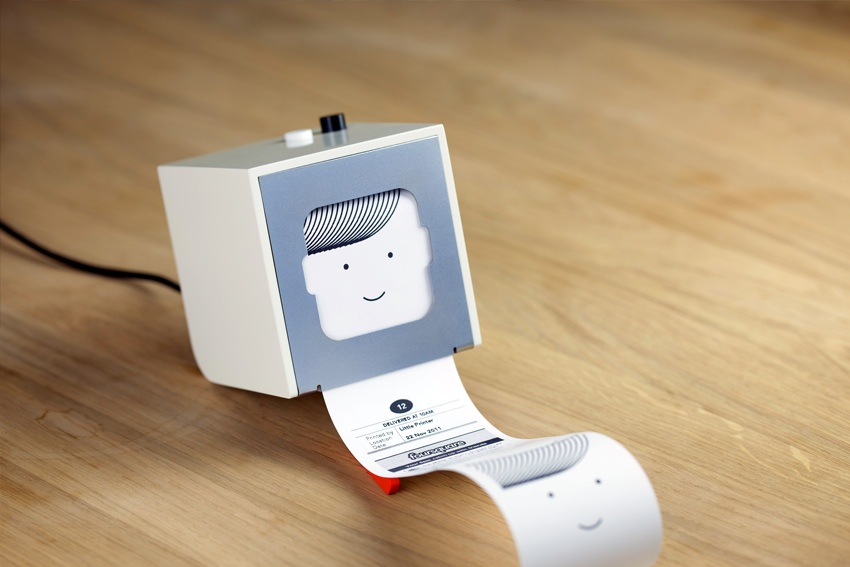
Little Printer lives in your home, bringing you news, puzzles and gossip from friends. Use your smartphone to set up subscriptions and Little Printer will gather them together to create a timely, beautiful mini-newspaper.
Generalizing as much as possible for the purpose of comparison, it can be most rudimentarily described as this:
Little Printer is a home printer and service to collect things you subscribe to and print them out in a mini-newspaper.
Simplifying the unique things about a product makes it easier to say things like, “that’s just like this other product,” or “I had that idea years ago,” despite those subjective, qualitative differentiators often being the very reason one product succeeds over another, rather than purely on specs. Product designers who make these claims rarely take the time (publicly, at least) to do a thorough analysis of the different choices made between the newly launched product and their unrealized idea. I feel it could be instructive to do so. This is what you’re reading now.
Printcast
May 30, 2005 - Engineer Mike Lambert and I came up with the idea for Printcast, which can also be most rudimentarily described as this:
Printcast is a home printer and service to collect things you subscribe to and print them out in a mini-newspaper.
Printcast took subscription content from RSS and Atom feeds and social networks, but it was intended to replace an actual newspaper in your life, swapping generic wire service news copy, tepid local reporting and advertisements with extremely personalized content.
Little Printer and Printcast share the same basic idea: a home printer, a service, selected content, social ties, portability of output, advertised as something physical and tangible, but BERG’s design choices make it a distinctly different device and I feel it has much more potential for success than a realized Printcast printer would have.
History and motivation
Well, there’s this, featured in Popular Science, May, 1939:
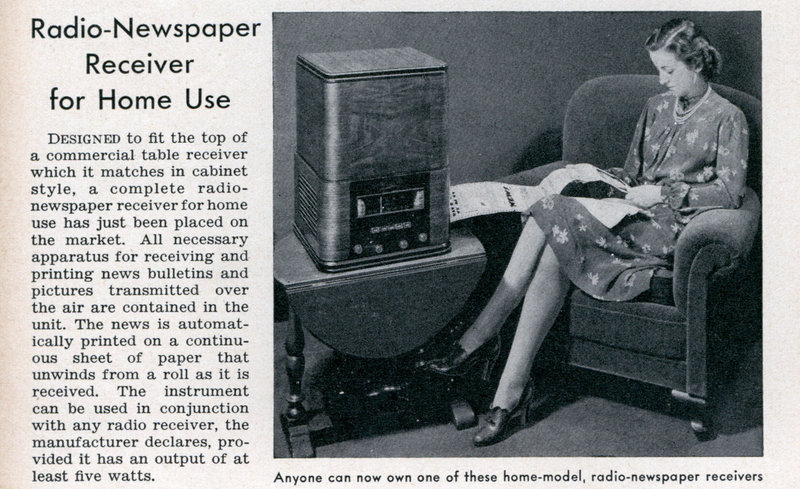
Through to 2005, there wasn’t a lot of really similar internet-based work (I’m sure there were a handful of fax-based systems like the above). Print-on-demand books and magazines weren’t suitable for daily delivery. HP Instant Delivery was closest: launched in 1998, it was software and a service that printed HTML pages from content providers to your normal home printer, but was discontinued in 2001.
Little Printer: BERG has hinted at this product for a year now, with references to paper displays and receipt form-factors in June 2011 and November 2010 (skip to 2:45 in the video).
In its announcement site, BERG only shows what the Little Printer does. It doesn’t present a motivation, give a reason, or show a slice of life improved by the Little Printer. Like much advertising, it doesn’t show a user so you can put yourself into the scene.
But, we don’t have personalized receipts today, and lots of commentary in social media around the Little Printer is, “why would I use this? Isn’t this wasteful?” It requires a bit of imagination to picture yourself looking at a receipt strip with your oatmeal in the morning; in this sense, BERG still has more explaining to do.
Five years ago, in October 2006, they mentioned a receipt printer for text messages and then what appears to be the direct predecessor of the Little Printer, their social letterbox. The social letterbox concept is written out, filled with pre-imagined scenarios: a mother sending newspaper clippings, friends sending photos; a way to enable more personalized, more meaningful communication than email. Once you have a “personal” printer, the idea of collated blog posts and automatically-delivered magazines is arrived at, but only as a result of the new form-factor provided by a “social letterbox” instead of “just a printer.” As a result, the idea of “just software” for an existing home inkjet or laser printer is discarded: “the social interactions change the physical device itself.”
Printcast: Six and a half years before BERG’s announcement and nearly a year and a half before their social letterbox, we came to the same conclusion with Printcast. I had suggested “just software” but Mike put forth the idea that it wasn’t compelling without a more optimized sort of printer. You already have a printer that you’re not using for this sort of thing, because home printers require a certain amount of maintenance: ink or toner and paper are in limited supply and inefficient to replace. You don’t want to be printing with that machine every day, and the first day you run out of supplies is the first step towards never using the service again. You need a different sort of printer, something disruptive. Quoting from our notes:
...a dedicated printing device for newsprint-quality print-on-demand. Ideally, this device would print out on 11x17 sheets (any larger would not be suitable for desks), double-sided, on pre-creased newsprint with reduced dpi (180dpi?). This gives the customer a four-page 8.5"x11" ‘broadsheet’ with a substantial amount of potential content. Grab the stack of sheets from the printer in the morning and fold in half, and go.
An economical duplex large-format printer would have content distribution uses beyond just daily newsprint. This would be suitable for printing entire book chapters on the fly e.g. for students (textbook chapters or as an alternative to expensive reading packets), commuters (book chapters for travel), publishers (print and markup content faster and cheaper) and others.
We did a little math and figured you could design a custom printer with two dot-matrix printer heads, one on each side, plus a paper cutter, that printed on roll newsprint, and lease them to subscribers for a fairly reasonable yearly subscription and maintenance fee, which would provide service with replacement paper and ink included.
The economics seemed to make sense. If the device could be pitched as replacing your daily newspaper subscription, you could provide the same wire service content the home reader is already getting, plus advertisements, plus selections of personal material, at half the price of a newspaper subscription, something like $150/yr., $10/mo., or thereabouts.
We considered it disruptive of both traditional home printing and mass-market newspapers and book printers and did a lot of market analysis. It seemed plausible. Except, neither of us really wanted to design a printer, so for a while I took the idea in different direction, which we’ll get to later.
Tone and positioning
Little Printer: The way BERG pitches the printer isn’t as a newspaper replacement, or a smartphone replacement. It’s as a pet, fetching you a toy for you to be entertained with for a moment, and only a moment. Like a receipt, it’s something you look at once or twice, something you use as a bookmark, something you pass along, something you read once more before you drop it in the shredder, and it’s done. It’s completely temporary, but unlike a receipt, a Little Printer printout is meant to bring a smile to your face. It’s old tech, maybe a little wasteful, but it’s positioned as something new and interesting and fun. It’s a luxury item.
Printcast: Printcast was positioned to replace a piece of old tech with the same old tech, except in an even more wasteful fashion, whitewashed with some new content. We were suggesting you get rid of your big, expensive, cost-effective mass-market newsprint presses and distribution networks and print things out yourself, with a custom dot matrix printer, first thing every morning. People aren’t looking to replace their newspapers with anything. They’re just getting rid of them. It was utilitarian.
Form factor and technology
We never built the printer or the service, so this is all about Little Printer.
Little Printer: If you look at our spreadsheet linked earlier, we considered carbon paper, but we didn’t consider thermal transfer paper at all. I checked all our transcripts. It just didn’t come up, and that’s a factor of the positioning of the device affecting the size of the output.
Size is important. If you’re directly replacing a newspaper, you need to be able have a bunch of content in there, relevant content, with the same affordances of convenience as a newspaper, so printing something out on freshly-cut 11x17 sheets is the smallest size that makes sense.
Six years and I-don’t-know-anyone-who-reads-a-newspaper-any-more later, the Little Printer isn’t replacing anything. If anything, it’s offering to put back a little regularly-printed novelty material into your life. BERG isn’t the only one moving in this direction: digital photo frame service Picwing pivoted into a printing service, and was acquired by another niche printing startup this year.
We also hadn’t looked at connectivity directly, but for devices without screens and buttons, connecting to a home network is hard. Wi-fi networks have long passwords, different encryption settings, overlapping channel signals and sometimes identical names, especially in dense areas like apartment buildings. Appliance-style networked devices like the Chumby are merely cumbersome to connect their first time; devices without onboard UIs, like Supermechanical’s Twine, risk having severe problems if naively designed (the Twine serves as its own wireless network until you provide it with the connection details of yours through a smartphone).
BERG’s solution of the “BERG Cloud Bridge” is an interesting answer. The bridge is “a small box that plugs into your broadband router. It’s this same box that will enable our other planned products in the BERG Cloud family.” So: the printer isn’t necessarily wi-fi, it just has to wirelessly talk to the bridge, and the bridge isn’t wi-fi, since it “plugs into” your router. This seems like a neat side-step of the networking problem. If the bridge is plugged into the router, it generally doesn’t have to do any special configuration; it’s implicitly trusted, and the router will supply it with networking parameters over DHCP. The bridge can then connect to the BERG Cloud web service and maintain that connection without the sorts of hacks that peer-to-peer systems have to resort to.
How to talk wirelessly to the printer? Looking at other thermal printer hacks, it seems to be common that they are serial devices. ZigBee, as pointed out by Peter Robinett, is an RF protocol for low power intra-device networking. Off-the-shelf ZigBee transceivers often work over serial; I can imagine the a Little Printer prototype being a stock thermal printer with a ZigBee transceiver attached to its serial port. ZigBee also supports autodiscovery of devices; perfect for a universal “bridge” device. In the Americas and Europe, ZigBee also has reserved spectrum, so it doesn’t have to interfere with wifi (it will everywhere else, though).
Content
In general, personalized content made physical always carries some attachment risk to it. A large format printed piece enclosing news of your family and friends may be harder to treat as truly “disposable” for users who are used to a separation between “impermanent” digital things and “important” physical things, even when printed on cheap newsprint. Thermally-printed receipts, despite the size difference and inherent self-destructive properties, may still cause some anxiety for users who can’t dissociate the meaning of the content from the physical presentation.
Little Printer: Little Printer’s content isn’t as long and text-heavy as Printcast’s would have been; you have to design for a receipt just like you design for mobile. Design is important. Compare these three visuals: a receipt-printer hack from 2009:

to one done last month:
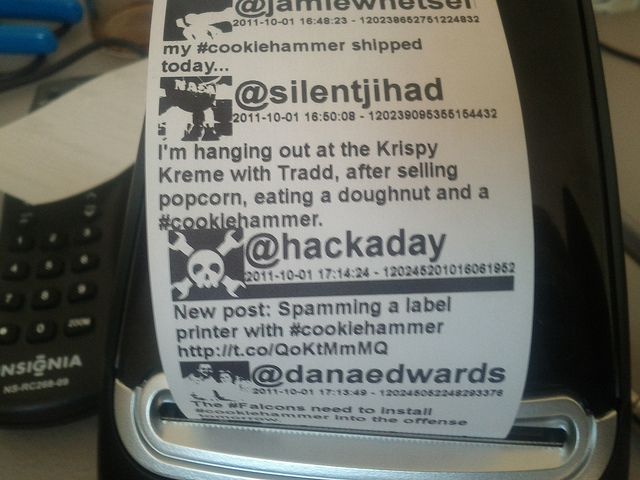
to a design from Little Printer:
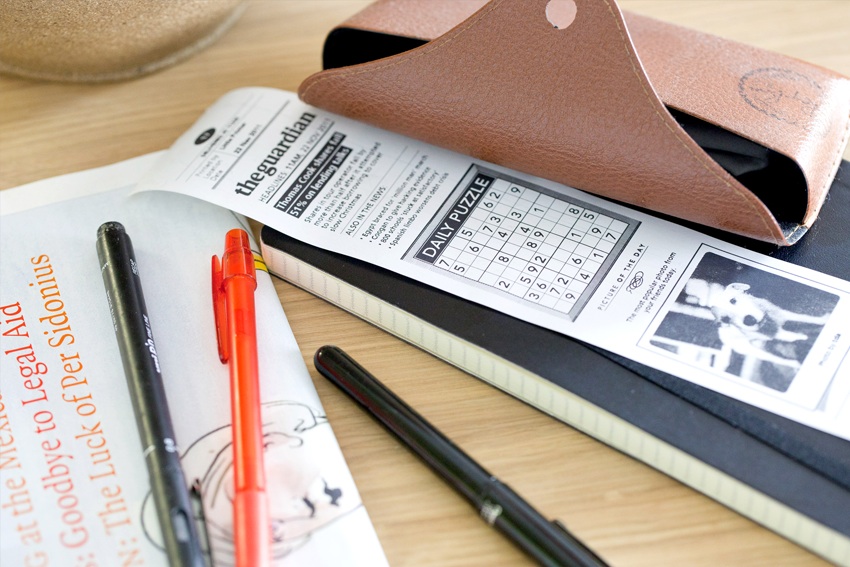
The latter is obviously compelling, but all demonstrate the limitations of the sort of content you can present. A receipt printer form factor is forcibly pushed towards short notes, summaries, small bits of art, the first paragraph only of a news article. It means content will have to be tailored for the device, to be custom and compelling in that size, not just reformatted, or you’ll risk disenchanting users as it becomes another wasteful outlet for spam.
Printcast: With Printcast, the idea was explicitly to shovel existing content onto paper with no novelty. This meant our differentiators couldn’t be content- or presentation-related at all, they were strictly around personalization and replacing the existing affordances of the newspaper.
Mike did consider a “Google Offline” pitch: feed the newspapers exclusively from Google-partnered content. News from Google News, feed content from Google Reader, ads from Google Adwords, upcoming events from Google Calendar. In this, we have some direct similarity to Little Printer’s Google-driven to-do list:
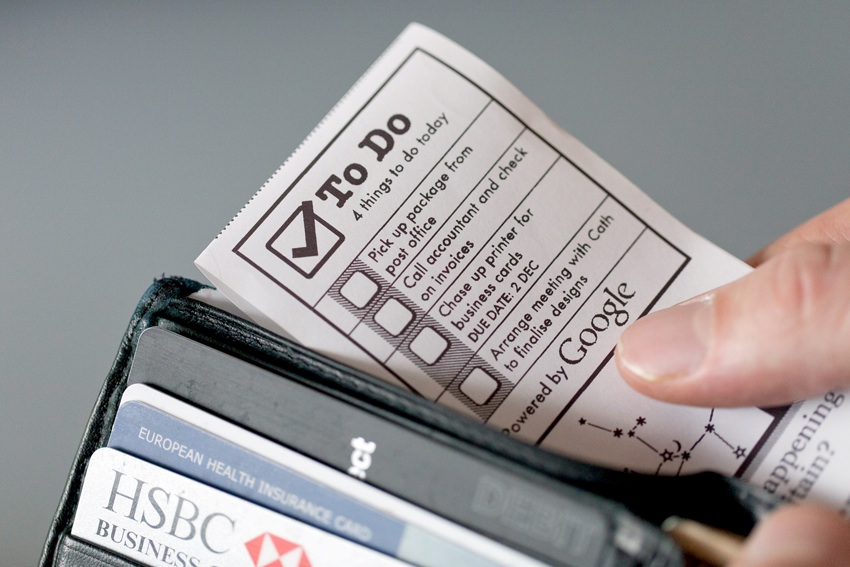
Socialization
Little Printer: Little Printer probably has the greater long-term potential for socialization factors: it’s not hard to hand someone else something the size of a receipt. It’s easy to show, it’s easy to talk about, it’s easy to write on the back of. However, as currently demonstrated, it’s missing a way to get in touch with the larger context of the presented content. I think we had this sorted with the second iteration of Printcast, but I’d be surprised if BERG didn’t already have it planned.
Printcast: After we realized we didn’t want to design a printer, I had a conversation with another long-time entrepreneur, Dave Taylor, and he suggested a different path, which I took to heart: rather than print at home, why not print an actual newspaper?
Those local ads for supermarkets and pizza parlors? Those are inserted by the local distribution centers and delivery networks. They’re printed and stuffed closer to home. How small a run of custom pages can a newspaper printer do? 300 copies, with the per-copy cost differential being negligible between 4-16 pages, as Newspaper Club suggests? Can you find 300 contiguous people or households with similar enough interests that you could print a custom, 16-page newspaper for that group? It turns out, maybe you can. Maybe you can print a newspaper insert customized at the neighborhood level, at the office building level, at the college dormitory level, at the college department level, using the existing newspaper delivery and printing infrastructure. You poll all of the subscribers’ social networks and RSS feeds and find the commonalities and publish related content.
But, it’s still paper, and now it’s less personalized. How do you increase the personalization and level of conversation and socialization around the closer-to-home but still less-discrete content?
Just a few months earlier, in March 2005, Matt Webb (later of Schulze & Webb, which became BERG), presented at O’Reilly’s Emerging Tech 2005 conference on the subject of radio, as he worked at BBC R&D with Matt Biddulph (who later became an early customer of Newspaper Club, along with Warren Ellis, who then worked with BERG on SVK), Tom Coates and Paul Hammond, and together they discussed some interesting projects: Programme Information Pages, which meant every individual broadcast of every individual programme on BBC radio had a unique URL; and PhoneTags, which let you send a text message to bookmark something you heard on the radio, and then view all the things you bookmarked, and then do all the social network things on them, like who else bookmarked that at the same time, who else bookmarked that regardless of when it played, what else did your friends bookmark, discussing bookmarks in time and space (e.g. “these were the songs being listened to when the towers fell” versus “I just like talking about this song”), etc.
This, I felt, was what newspapers were missing, and what would bring greater discussion and socialization to these 300-person newspaper-driven social networks. The newspaper would have an SMS shortcode, and each article would have an SMS keyword and a permanent URL. You could text the keyword to the newspaper’s shortcode and bookmark it, or visit the URL manually, and participate in the ongoing discussion. As personalized content was being pulled from the web, it was likely to have trackbacks and pingbacks and other ongoing references, and things like Google News Alerts could be attached to the subject. You had more in common with any other viewer of this URL because not only were you interested in it, but you’re physically proximate to everyone else who can see it. You could go have this discussion in person, which is a boon for advertisers. From a personal value perspective, it also meant that everything you bookmarked, and all of the paper content you visited online, whether it was just to downvote the ads and upvote the articles you liked, could drive the algorithms that picked the next day’s content, ensuring that the paper continued to be relevant to you.
I would be surprised if each piece of content printed out by the Little Printer didn’t have a unique Twitter hashtag and shortened URL either pointing back to the original source, or to a bookmark and discussion site in the BERG Cloud service.
Little Printer has possibility
Printcast wasn’t the first or last idea of its kind, but Little Printer is the first to do something truly novel and interesting with the concept, to carve out a new format in the way we interact with temporary, personal, physical information, such that it has the chance to not just be personalized, but be intimate. Its motivations come from the right place. Its tone and positioning are good for a novel, luxury device (although I feel BERG should take on some pre-imagined scenarios as they did in their “social letterbox” article). If they can provide compelling, well-designed content and enable the socialization of that content, I think Little Printer could be at least a critical success in a way that purely digital appliances in this niche (Audrey, I-Opener, Chumby) have not been.
I’m Vitorio, it’s November 30, 2011, thanks for reading. Tweet
Other Printcast-style systems and discussions
- 2002: Web News
- 2005: My Printer-Based, Personal Daily Magazine
- 2005: Roundtuit :: Custom, RSS based Magazine, for the Tube :: December :: 2005
- 2006: Guardian launches printable internet edition | Press Gazzette
- 2007: Google Magazine?
- 2007: FeedJournal - The Newspaper You Always Wanted
- 2007: ShelfMade
- 2009: About the Printed Blog | The Printed Blog
- 2009: Tabbloid
- 2009: Back to the future: MediaNews revives “print your own newspaper” Nieman
Other future-of-newspapers commentary
- 2006: Topix.net Weblog: What do newspapers do????
- 2006: paulconley: Students, teachers and visionaries
- 2006: The New Yorker: The Talk of the Town
- 2006: WSJ.com - The Perfect News Site, 2016
- 2009: The Rumpus Long Interview With Dave Eggers - The Rumpus.net
- 2009: Subtraction.com: Funny Pages
- 2009: YCRFS 1: The Future of Journalism
- 2009: Five Key Reasons Why Newspapers Are Failing | Politics & Media |
A note on having had a similar idea
I originally titled this piece a “parallel invention teardown.”
It’s a common trope in entrepreneurship circles that ideas are worthless, execution is everything; and the theory of multiple discovery (or simultaneous or parallel invention) posits that once all of the prerequisites for a discovery exist, its invention is inevitable. In other words, you probably weren’t the first to think of it, you probably won’t be the last to think of it, and it really is a race to be best-of-market, not just first-to-market.
As product designers, it should be instructive to take apart the two and compare and contrast, discovering the different choices in trade-offs they made, noting where they might have a problem you already accounted for, and only then deciding if they did it first, or if they did it better.